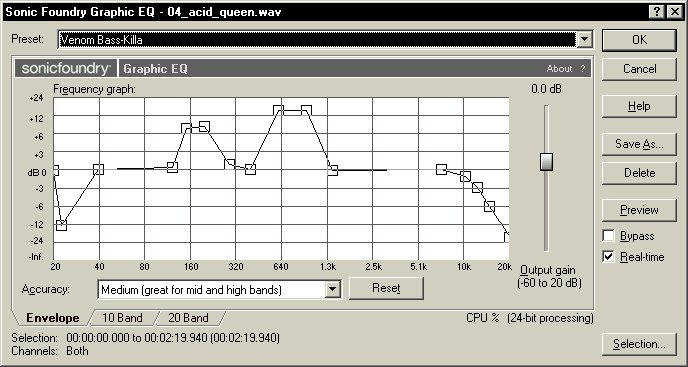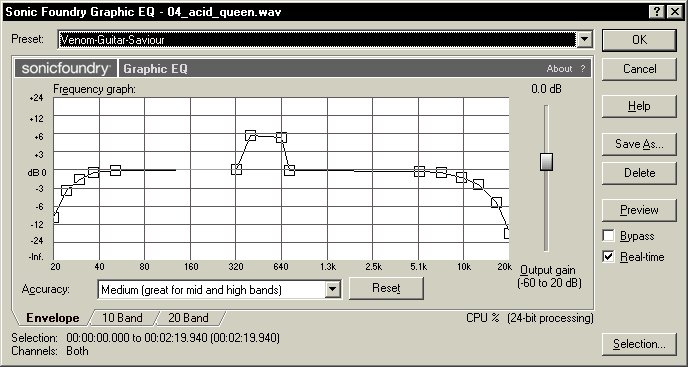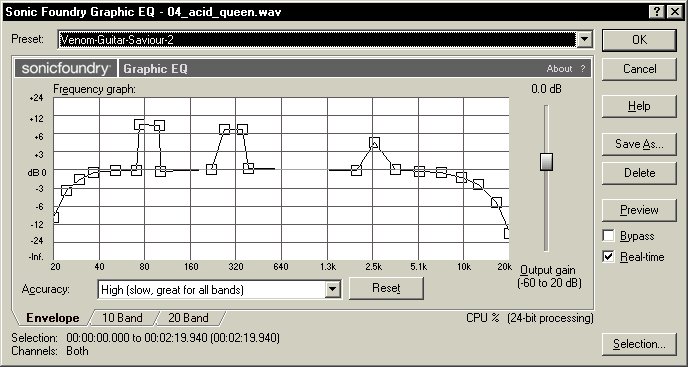Search Results:
What a big difference a little eq makes...
posted on 16 Feb 2007 under category History
Part of my mission with this blog, besides being a music-musing thing and news outlet for my bands and labels and such, was that it would serve, hopefully, as a bit of a helpdesk for people who do their own DIY home PC recordings. Or maybe a ‘forum’ is a better word than helpdesk because I can learn as much or more than I can teach - as a recent example showed me. And, hopefully, me sharing it can help head off some trouble for someone else.
The issue this time was EQ. Something I’ve heard a lot in my time was the importance of proper EQing when mixing, and how mixing is as much, or more, about EQing the instruments to fit together rather than just setting levels and panning. I really took that to heart in the past few years, and that’s why basically everything I’ve done on Displeasures and since then sounds better, or at least more controlled, than my earlier recordings. Not that my MO changed that much: basically, I work ahead of time in pre-production by getting good instrument sounds BEFORE recording so that I don’t have to mess with EQing later. And that means not just getting individual sounds, but working the guitars and bass together so that each sound works not only on its own but fits together without stepping on each other’s toes.
I did this before Displeasures, of course, but more haphazardly, and with less planning. Sometimes I got good sounds, as on Monolith…, but sometimes it was less than optimal (think “The Spectre” from This End Up, where the bass is almost lost in the mix). When it worked, it was more chance than contrivance.
Anyway, what drove this point home was my recent remixing of the old Venom tribute tracks for the upcoming Rampage/Chemikiller split tribute.
I recorded the basic tracks WAY back when, I think around Monolith. I was still using TiMIDIty to spool out drum files, and the song file cabinets I saved were in Cakewalk 7 format. These are ancient. At the time, I wanted a really filthy sound, and I had just gotten a new Boss DS-1 Distortion pedal - the orange one. It’s the same thing Megiddo used to use in their demo days, so I thought it would be cool to use that to get a somewhat similar sound - and it had a really rough, nasty sound. I used the full-bore distortion setting for both guitars and bass, recorded the tracks quickly, and then left them.
Megiddo kept pushing their half of the split back, and I kept getting busy and working on other things, so the tracks basically just sat on my hard drive, untouched, for years. I had even spun out first-cut rough mixes just to hear what I played, but never bothered to burn them to disc. Well, when I finally got word that Megiddo dropped, and Chemikiller joined on to do the split instead, I went and found these tracks. I burned them and gave them a listen.
And then I vomited. They sounded like total dogshit. Click HERE if you don’t believe me - this is the first rough mix of Bloodlust. See, the exact same sound is being used for guitars and bass, so the distortion waves are almost identical, making it really easy for the bass to get lost behind the guitar (since the frequencies of guitar are higher and more prominent). Worse, you hear just how rough the distortion of that pedal is. Lots of muddy mush, lots of high-end static and noise. Furthermore, to get the bass to stand out at all, I really had to push it, which ended up making it fight with the guitar sound-wise, really squeezing out the rest of the spectrum. The vocals are so buried just because any higher would have peaked them out and make the sound even worse than it is.
And all this because guitar and bass are fighting for the same sonic space. This is EXACTLY what EQ is able to fix.
After some digging, and more hurdles involved in file format conversion from CW7 to Sonar 2, I managed to get working, mixable Sonar files for these tracks. I experimented more with levels and panning, but even those could only do so much to make these sound halfway decent - and that ‘so much’ was nowhere near enough. I decided that EQ was my last chance before rerecording these, something I really didn’t want to do.
I started with the bass. The issue, as you can hear here, is that the bass is somewhat present, but quite thin, and mostly up in the guitar range of the sonic spectrum. The midrange is where the bulk of the bass guitar’s frequency range lies, so I started working with Sound Forge’s graphic EQ. I put in a midrange boost, about 12 db at a range of about 640Hz to 1KHz. It sounded a LOT more full and present, somewhat like that thick, rumbling sound Cronos got on the Eine Kleine Nachtmusik album. I thought it could still use more balls, so I added another narrower, lower-pitched boost, so that I ended up with a two-peak boost EQ. Well, to help with the noise, I also cut a lot of the ultra-lows and rolled off the very top end. I ended up with something that looks a little like this: 
Next, the guitar was up. Noise reduction as such was out of the question, but I thought a midrange boost would add some clarity, while also rolling off the extreme highs and lows would help with the noise/static topping and the low-end mud. I took the BassKilla EQ filter above, rolled off the lows and highs, and deleted that lower boost. It looked like this:

I mixed, excited to hear what the EQ did, and it came out better, but worse - the bass was much more present, but now it was the guitar that was mostly missing! Then I thought about the problem, and realized why. Bonus Point - Can you tell me why? (And no cheating, so don’t read on to the next paragraph.)
Anyway, if you looked at the two pics above, you see the problem - I was STILL EQing the guitar and bass to fill the same space. I loved the bass tone, though, and boosted so many frequencies there, that I thought I’d really shot myself in the foot guitar-wise. But I gave it a swing anyway - going back to the original guitar tracks and EQing those again, keeping the low/hi rolloffs but this time moving the midrange boost down to that little valley between the two bass boosts, and then adding a couple more boosts, one above the higher bass boost, one below the lower one:

I mixed down, exported, burned, and gave them a listen. Can you guess how happy I was? Bonus point - click HERE and listen, then tell me.
And that, my friends, is how a little EQ work can go a long way toward fixing a bad mix or helping a good one work even better. Specific guidelines have been given by many, but I prefer to be driven more by principles than actual rules. Let your ears and the ultimate goal for your end product be your guide, but keep in mind the FULL mix, not just each instrument in isolation, and don’t be afraid to iterate more than a few times. Do this, remembering to give each instrument its own space to fill and you’ll have instruments blending for a great effect instead of fighting each other for space.
And ALWAYS remember to archive your basic tracks before big changes like this so you have a baseline to return to if you f#@k up. That’s one rule that IS absolute. Or should be, anyway.
(I’m very happy I made this post - I liked to give nuts-n-bolts insights into my working process at the time, and it serves as a nice time capsule into what I was working on in general back then. I don’t recall now if I had already decided to split the Venom release with Chemikiller. Probably, because the tracks were just going to sit in mothballs forever. One of my other future projects is to dredge up and go through all of my old email programs and find the emails relating to important things I was working on. I’ll confirm if this was the case.)